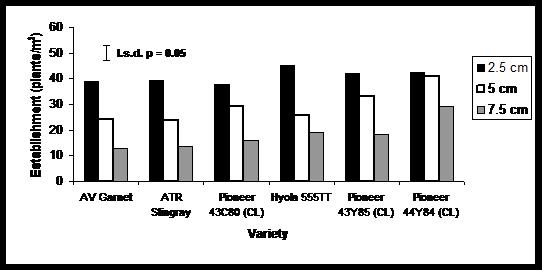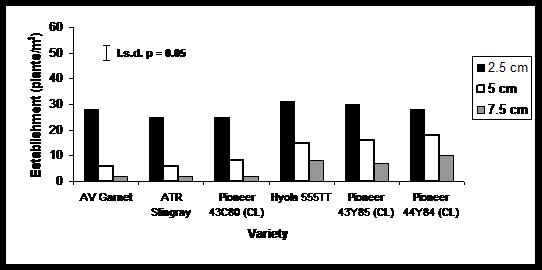Canola establishment; does size matter?
Canola establishment; does size matter?
Author: Rohan Brill, Leigh Jenkins and Matthew Gardner | Date: 05 Feb 2014
Rohan Brill1, Leigh Jenkins2 and Matthew Gardner³,
1NSW DPI Wagga Wagga,2NSW DPI Trangie,³AMPS Agribusiness (formerly NSW DPI Tamworth)
Take home messages
- Aim to sow large (>5 g/1000 seeds) canola seed to achieve adequate establishment rates from early sowing.
- Hybrid vigour (heterosis) has an indirect effect (larger seed size) and a direct effect (enhanced vigour) on canola establishment
- Avoid the application of high rates of phosphorus in direct contact with canola seed at sowing
Introduction
Research in the southern region has almost universally shown a negative correlation between canola sowing date and grain yield. The challenge though is that earlier sowing of canola is generally (but not always) more risky for successful crop establishment. Therefore the overall aim of this research was not to improve canola establishment per se, but to increase the likelihood of achieving an adequate plant stand from sowing canola on time or early. The results reported here have greatest relevance for an early planting opportunity and a lesser relevance for canola that is dry sown or planted into moisture in May.
Sowing depth trials
Sowing depth trials were conducted at Coonamble, Nyngan and Trangie in 2012 and at Nyngan and Trangie in 2013. Each trial had six common varieties with a range in seed size (Table 1). Target seeding depths were 2.5 cm, 5 cm and 7.5 cm.
Table 1. Seed size and number of seeds sown in three canola variety sowing depth trials in 2012
|
Variety |
Seed weight 2012 (g/1000 seeds) |
Seed weight 2013 (g/1000 seeds) |
Seeds sown/m² |
|---|---|---|---|
|
AV-Garnet |
3.78 |
3.27 |
60 |
|
ATR-Stingray |
3.06 |
2.97 |
60 |
|
Pioneer 43C80 (CL) |
3.68 |
4.11 |
60 |
|
Pioneer 43Y85 (CL) |
5.03 |
4.77 |
60 |
|
Pioneer 44Y84 (CL) |
5.34 |
5.20 |
60 |
|
Hyola 555TT |
4.26 |
4.00 |
60 |
In 2012, averaged across all trials and varieties, establishment (as a percentage of seeds sown) at the 2.5 cm target depth was approximately 66%, with no difference between varieties. All varieties had reduced establishment at the 5 cm sowing depth compared to the 2.5 cm sowing depth with the exception of Pioneer 44Y84 (CL) that had the largest seed (Fig. 1). At the 7.5 cm sowing depth the difference between varieties and seed size became more marked as the largest seeded variety achieved 50% establishment compared to 20% establishment for the smallest seeded variety.

Figure 1. Establishment of six canola varieties at three sowing depths, averaged across three trials at Coonamble, Nyngan and Trangie in 2012.
The effect of sowing depth on grain yield in 2012 was less marked than the effect on establishment. At Nyngan and Coonamble, the 7.5 cm target depth yielded approximately 250 kg/ha less grain than the 2.5 cm and 5 cm target depth. At Nyngan, Pioneer 44Y84 (CL) had no grain yield reduction at the 7.5 cm target sowing depth compared with the shallower sowing depths, however there was a significant grain yield reduction for all other varieties as a result of deep sowing. There was no effect of sowing depth on grain yield at Trangie.
In 2013 the overall establishment achieved was less than 2012. At the 2.5 cm sowing depth establishment was approximately 50% with no significant difference between varieties (Figure 2). All varieties had reduced establishment at the 5 cm sowing depth compared with the 2.5 cm sowing depth; however the reduction was less severe for the hybrids than for the open-pollinated (OP) varieties. Establishment was further reduced at the 7.5 cm sowing depth, with a similar hybrid advantage as occurred at the 5 cm sowing depth.
Figure 2. Establishment of six canola varieties at three sowing depths, averaged across two trials at Nyngan and Trangie in 2013.
The effect of sowing depth on grain yield was greater in 2013 than 2012 but was still of a lesser magnitude than the effect of sowing depth on establishment. At Nyngan, the grain yield of Pioneer 44Y84 (CL), AV-GarnetA and Hyola 555TT were all similar for the 2.5 cm sowing depth; however AV-GarnetA and Hyola 555TT both had a significant grain yield reduction at the 5 cm and 7.5 cm sowing depths, while Pioneer 44Y84 (CL) did not suffer a yield penalty from deeper sowing. At Trangie, all varieties suffered a grain yield penalty as sowing depth was increased but this reduction in grain yield was less severe for the larger seeded varieties.
Is seed size or plant type the key?
To determine if improved establishment is related to hybrid breeding or simply seed size the seed of each variety was graded into two size categories; large (2 - 2.4 mm diameter) and small (1 – 1.4 mm diameter). Twenty seeds of each variety and seed size category were sown at depths of 2.5, 5 and 7.5 cm in pots and placed in a glasshouse.
Similar to the field trial results the 2.5 cm planting depth had the highest establishment percentage and increasing planting depth to 5 and 7.5 cm significantly reduced establishment by 32 and 51% respectively, averaged across all varieties.
The small seeded OP varieties had the poorest establishment for each planting depth (Table 2). The large seeded hybrid and OP varieties had significantly better establishment compared to their respective small seeded varieties at both the 5 cm and 7.5 cm planting depths. Small seeded hybrids had significantly better establishment than the small seeded OP varieties (Table 2). This establishment data suggests that large seed as well as the heterosis advantage of hybrids contributes to improved establishment.
Dry matter of 100 plants was measured 15 days after emergence to give an indication of early plant vigour. The large seeded hybrids had the greatest dry matter accumulation at all sowing depths. Compared with the large seeded treatments, the small seeded treatments (hybrid and OP) accumulated less dry matter and had a greater reduction in establishment where planting depth was increased. The early vigour advantage hybrids displayed over OP varieties that was observed for the large seeded treatments was not observed for the small seeded treatments, with hybrid and OP varieties accumulating similar dry matter per plant.
These glasshouse findings indicate that the establishment and early vigour advantage of hybrids is mostly due to their larger seed size, but also partly due to the heterosis advantage of hybrid breeding.
Table 2. Plant establishment, days to emergence and 100 plant weights (15 days after emergence) for three hybrids (Pioneer 44Y84 (CL), Hyola 50 and Hyola 555TT) and three open pollinated (Pioneer 43C80 (CL), AV-Garnet and ATR-Gem) canola varieties segregated into large and small seed sown at three planting depths.
|
Planting depth |
Hybrid |
Open-pollinated |
||
|---|---|---|---|---|
|
Large seed |
Small seed |
Large seed |
Small seed |
|
|
Establishment |
||||
|
2.5 cm |
19.4a |
19.8a |
19.4a |
16.3b |
|
5.0 cm |
18.8ab |
12.8c |
17.4b |
8.8d |
|
7.5 cm |
15.9b |
3.8e |
8.7d |
1.0f |
|
Days to emergence |
||||
|
2.5 cm |
5.0a |
5.1a |
5.1a |
5.2a |
|
5.0 cm |
5.9ab |
6.7b |
6.8b |
7.2b |
|
7.5 cm |
7.4b |
11.3e |
8.7c |
10.0d |
|
100 Plant weight 15 days after emergence |
||||
|
2.5 cm |
56.9a |
31.5d |
45.7c |
29.7d |
|
5.0 cm |
51.8b |
24.5e |
44.9c |
23.5e |
|
7.5 cm |
49.5b |
10.3g |
45.8c |
13.0f |
**Numbers within each section (e.g. Establishment) designated with a different letter are significantly (P=0.05) different.
Starter fertiliser trials
At each trial site in 2012 a phosphorus rate trial was also sown. The phosphorus product used was triple super which does not supply any nitrogen with the phosphorus. The phosphorus rates applied were 0, 5, 10 and 20 kg/ha, with the fertiliser being placed directly with the seed.
There was no effect of phosphorus rate on canola establishment on the cracking clay (Grey Vertosol) soil at Trangie. In contrast, increasing P rate significantly reduced the establishment of all varieties on the lighter textured soils at Nyngan (Red Chromosol) and Coonamble (Brown Chromosol) (Figure 2). All varieties experienced a similar reduction in establishment, regardless of seed size or plant type.

Figure 3. Average establishment of four canola varieties sown with four rates of phosphorus at Trangie, Nyngan and Coonamble in 2012.
Two further phosphorus trials were conducted in 2013, with the Trangie trial planted on a lighter textured soil (Red Chromosol) compared with a heavy (Grey Vertosol) soil in 2012. There was a significant establishment reduction at both sites as phosphorus rate (applied as triple super) increased (Figure 3). Further product comparisons at a common P rate showed that all major phosphate fertilisers (MAP, DAP, Single Super, Triple Super, Supreme Z) affected establishment to a similar degree. Despite the effect on establishment, grain yield still responded positively to phosphorus at Nyngan, with the 5 kg/ha P rate yielding 0.25 t/ha more than the nil P treatment but with no further yield increase beyond this rate.

Figure 4. Average establishment of two canola varieties sown with four rates of phosphorus at Trangie and Nyngan in 2013.
For growers using a tine seeder it is generally possible (and recommended) to separate seed and fertiliser to avoid the negative effects of starter fertiliser. For growers with a disc seeder (or considering a disc seeder), there are several management options available such as:
- Planting on relatively narrow crop rows to reduce fertiliser concentration in the furrow.
- Plant canola early allowing greater root exploration, with potentially less phosphorus application required.
- Pay strict attention to closing devices. The firmer/heavier the closing device, the greater the negative impacts of phosphorus fertiliser.
Conclusion
To maximise grain yield potential canola needs to be planted early. This requires careful attention to detail in relation to crop establishment. Since the soil surface dries out more rapidly in early-mid April compared to mid-May, seed may need to be planted slightly deeper than optimal (up to 5-6 cm deep). In this early planting situation, pay strict attention to seed quality. Sowing large seed (> 5 g/1000 seeds) results in an increased likelihood of achieving an adequate establishment. For growers who wish to purchase seed, hybrid seed is generally larger than open pollinated seed. For growers who retain open-pollinated seed on farm for their own use, aim to clean seed with a 2 mm screen.
Phosphorus is essential for canola growth, but starter fertiliser may have an effect on crop establishment. Avoid high rates of phosphorus in direct contact with canola seed at sowing. Further research is required on phosphorus nutrition of canola, especially on the interactions between P application and sowing time and the effect that liquid phosphorus products may have on canola establishment.
Contact details
Rohan Bril
Wagga Wagga Agricultural Research Institute
02 6938 198
GRDC Project Code: DAN00129,
